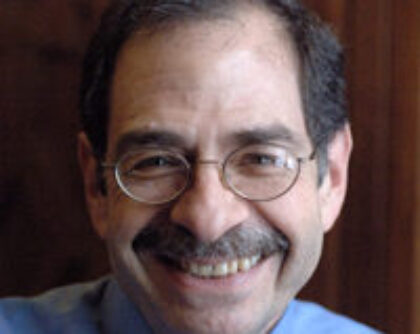Marc A. Kastner
Research Interests
Professor Kastner’s group is studying the motion of electrons in nanometer-size semiconductor structures, in which the motion of electrons is highly correlated. In simple metals and semiconductors, like Aluminum and Silicon, each electron moves as though it were independent of all the others. The Coulomb interactions of the other electrons creates an average potential that changes things like the electron’s effective mass, but for the most part, a single-electron picture is adequate.
In many materials, like transition-metal oxides, the electrons are highly localized and the motion of each electron strongly affects the motion of the others. In the past few decades, the techniques developed for the electronics industry have allowed us to create artificially localized electrons, which also display strong correlations. One example is the single electron transistor. This is a device, in which electrostatic fields confine electrons to a small region of space inside a semiconductor. The confinement causes the number of electrons in the small region to be quantized, and other effects of strong correlations, such as the Kondo effect, can be observed.
While one confined droplet of electrons can be studied in a single electron transistor, it is also interesting to study arrays of confined regions. Kastner’s group is doing this in collaboration with Prof. Moungi Bawendi’s Group of the MIT Department of Chemistry. In this case, the system consists of arrays of identical nano-crystals grown by a colloidal chemistry technique.
Correlations also play a crucial role in the fractional quantum Hall effect. Kastner’s group is using tunneling to study the properties of the quasiparticles in these unusual states. Metallic gates, defined by electron-beam lithography, are used to bring counter-propagating chiral edge states close enough together for quasiparticles to tunnel between them. The dependence of the tunneling rate on bias and temperature reveals some of their properties. Kastner’s group is attempting to make devices, in which the quasiparticles interfere with themselves. These are needed to test the predictions of some theories that the quasiparticles have non-Abelian statistics; that is, interchange of two quasiparticles changes the wave-function in a profound way, not just the usual change of phase.
Biographical Sketch
Professor Marc Kastner joined the Department of Physics in 1973, was named Donner Professor of Science in 1989, appointed Department Head in February 1998, and in July 2007, became Dean of the School of Science. A graduate of the University of Chicago (S.B. 1967, M.S. 1969, Ph.D. 1972), he was a research fellow at Harvard University prior to joining MIT.
He served as Head of the MIT Department of Physics Division of Atomic, Condensed Matter, and Plasma Physics from 1983 to 1987, and as Associate Director of MIT’s Consortium for Superconducting Electronics—a collaborative program designed to advance the technology of thin-film superconducting electronics—from 1989 to 1992. He served as Director of MIT’s Center for Materials Science and Engineering from 1993 to 1998.
Awards & Honors
- 2008 // National Academy of Sciences Member
- 2000 // Oliver E. Buckley Condensed Matter Physics Prize Recipient (APS) ""For pioneering contributions to single electron effects in mesoscopic systems."
- 1995 // David Adler Lectureship Award in the Field of Materials Physics (APS) "For his pioneering work on amorphous semiconductors on narrow band oxides with emphasis on both the magnetic and transport properties of high Tc superconductors and most recently, on nanoscale semiconductor structures."
- 1988 // DOE Division of Materials Sciences Outstanding Scientific Accomplishment Award
- 1981 // American Physical Society Fellow
Key Publications
-
Kastner, M. A., Goldhaber-Gordon, D., Kondo Physics with Single Electron Transistors, Solid State Communications, 119 (2001) 245-252.
-
Kastner, M. A., The Single Electron Transistor and Artificial Atoms. Annalen der Physik, 9:885 (2000).
-
Kastner, M. A., R. J. Birgeneau, G. Shirane and Y. Endoh., Magnetic, Transport, and Optical Properties of Monolayer Copper Oxides. Reviews of Modern Physics, 70:897 (1998).
